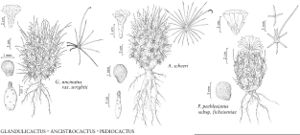Difference between revisions of "Ancistrocactus scheeri"
Cact. 4: 4. 1923.
FNA>Volume Importer |
imported>Volume Importer |
||
| Line 8: | Line 8: | ||
}} | }} | ||
|common_names=Root cactus | |common_names=Root cactus | ||
| + | |special_status={{Treatment/ID/Special_status | ||
| + | |code=F | ||
| + | |label=Illustrated | ||
| + | }} | ||
|basionyms={{Treatment/ID/Basionym | |basionyms={{Treatment/ID/Basionym | ||
|name=Echinocactus scheeri | |name=Echinocactus scheeri | ||
| Line 63: | Line 67: | ||
|publication title=Cact. | |publication title=Cact. | ||
|publication year=1923 | |publication year=1923 | ||
| − | |special status= | + | |special status=Illustrated |
| − | |source xml=https:// | + | |source xml=https://bibilujan@bitbucket.org/aafc-mbb/fna-data-curation.git/src/bb6b7e3a7de7d3b7888a1ad48c7fd8f5c722d8d6/coarse_grained_fna_xml/V4/V4_392.xml |
|subfamily=Cactaceae subfam. Cactoideae | |subfamily=Cactaceae subfam. Cactoideae | ||
|genus=Ancistrocactus | |genus=Ancistrocactus | ||
Revision as of 23:14, 27 May 2020
Plants unbranched (unless injured) until very old age, then few branched from ground level, precociously conspicuous. Roots long, fleshy, tuberlike taproots with bulbous swellings, sometimes having bulbous secondary roots, frequently horizontally oriented. Stem cylindric to club-shaped and stipitate, or spheric, to 17 × 8 cm. Spines: radial spines 13–28 per areole, translucent yellowish, tips red-brown, longest spines 6–28 × 0.15–0.55 mm; central spines 3–4 per areole; abaxial central spine 1 per areole, hooked (very rarely straight), ± terete or adaxially flattened, generally whitish or light brown, sometimes adaxially dark striped with brown to black, 12–38 mm; adaxial central spines (2–)3 per areole, erect, straight, dorsiventrally compressed, abaxially tan to whitish, adaxially brown to dark reddish brown, 19–50 mm. Flowers: inner tepals consistently bright green to yellowish (rarely pink to pale reddish). Fruits 19–35 mm. 2n = 22.
Phenology: Flowering Nov–Mar.
Habitat: Tamaulipan thorn scrub, plains and low hills, sandy, loamy, silty, or gravelly soils [rarely on shale]
Elevation: 20-500 m
Distribution

Tex., Mexico (Nuevo León, Tamaulipas).
Discussion
The roots of Ancistrocactus scheeri are diagnostic at all ages; frequently they are horizontally oriented, sausage-shaped or otherwise strongly tuberlike, but always separated from the stem by a fragile constriction, in contrast to the short, succulent, vertical taproots of A. brevihamatus. When separated from the tuberlike roots, stems of A. scheeri in horticulture will develop their peculiar succulent root systems, even in the artificial environment of a container.
Seedlings and immature plants of A. scheeri often have narrowly cylindric stems and numerous tightly appressed, pectinately arranged, short radial spines. With age, the stems broaden distally and new spines are longer, coarser, and less tightly appressed.
Adult plants of Ancistrocactus scheeri and A. brevihamatus are relatively similar above ground. The stems of immature A. brevihamatus, however, are not obscured by spines and are often flush with the soil surface, whereas those of A. scheeri are nearly hidden by spines and fully exposed above the soil.
Ribs on the stems of Ancistrocactus scheeri seem straighter and better defined than ribs of A. brevihamatus, even prior to sexual maturity.
Selected References
None.
